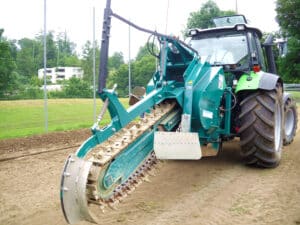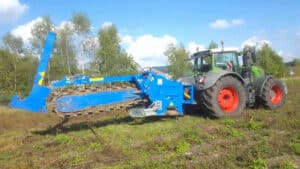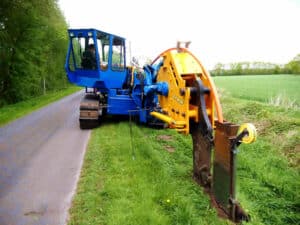How does tillage with the trencher work?
Trenching is a process of loosening and breaking up the soil in a specific area to aerate plant roots and improve nutrient uptake. Here are the steps you need to follow to perform tillage with a trencher:
- Preliminary work: Before you start working the soil, you need to prepare the area in question. Remove any rocks, branches, or other obstructions from the surface so that the trencher can work unimpeded.
- Depth setting: Set the depth of the trencher to the desired setting. Depending on the needs, the depth of the trencher can be adjusted to achieve the desired loosening of the soil.
- Trenching: Begin trenching by lowering the trencher into the ground and slowly moving it forward. The teeth on the bottom of the trencher cut the soil as the trencher moves through the soil.
- Repeat: Repeat the process until the entire area you want to machine has been milled. If the soil is very heavy and compact, it may be necessary to repeat the procedure several times to achieve sufficient loosening of the soil.
- Smoothing: When you have finished milling, you can smooth the floor with a rake or rake to remove any unevenness.
- Sowing: If you prepare the soil for sowing, you can now sow seeds and gently work them into the soil.
Tillage with a trencher can loosen and aerate the soil and improve nutrient uptake. However, it is important not to compact the soil too much after tillage so as not to nullify the effect of tillage.
Advantages of the trencher
Trenching is an efficient and time-saving method of preparing the soil for various purposes. Some of the advantages of trenching are:
- Speed: trenchers can quickly and efficiently loosen and dig up the soil, preparing it for seed sowing or other purposes.
- Precision: The setting of the trencher allows the depth and width of the soil trench to be precisely controlled, which is useful for certain applications such as laying pipes or installing drainage.
- Less physical effort: Using trenchers reduces the physical effort required to manually dig and dig around the soil, resulting in a lower risk of injury.
- Less soil compaction: Unlike other methods, such as using tractors or plowing, trenching can reduce soil compaction and damage to the soil, preserving soil quality.
- Flexibility: Trenchers can be used in a variety of soil types including clay, loam and sand, making them a versatile option for tillage.
- Less waste: Trenching produces less waste than other methods because the excavated material can be reused.
Overall, trenching provides an efficient and precise method of preparing soil for various purposes, saving time and money.
Suitable trenchers for soil processing are:

GM 140 H excavator attachment trencher
The GM 140 H trencher from Lingener Baumaschinen is a powerful excavator-mounted trencher designed for use on excavators. It is particularly suitable for use on

GMV 100 – working with a mounted plow
When it comes to efficient tillage and maximum yields, the mounted plow is an indispensable tool for farmers and agribusinesses. The cultivation plow is a

Cable laying with the GM 180 AF
Cable laying with the GM 180 AF The GM 180 AF trencher from Lingener Baumaschinen is a specialized machine for cable laying. It can effectively

Broadband trenching – the perfect machine GM 4 Allrad
In the modern world, fast and reliable Internet is indispensable. From streaming movies and music to working from home, effective communication and collaboration in today’s



























































